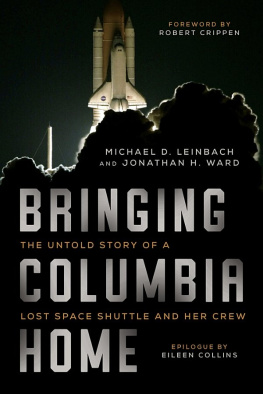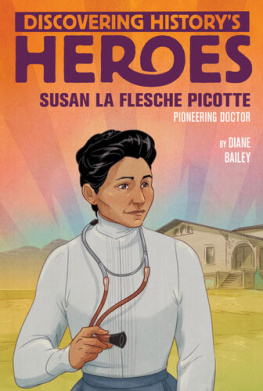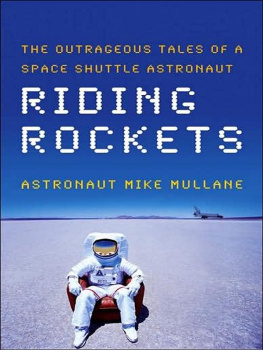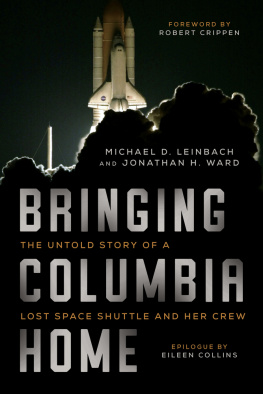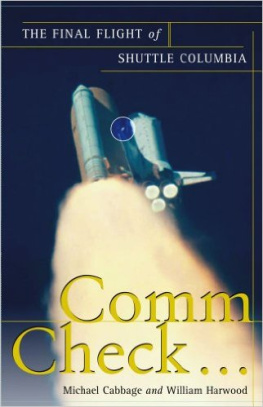Copyright 2018 by Michael D. Leinbach and Jonathan H. Ward
All rights reserved. No part of this book may be reproduced in any manner without the express written consent of the publisher, except in the case of brief excerpts in critical reviews or articles. All inquiries should be addressed to Arcade Publishing, 307 West 36th Street, 11th Floor, New York, NY 10018.
First Edition
Arcade Publishing books may be purchased in bulk at special discounts for sales promotion, corporate gifts, fund-raising, or educational purposes. Special editions can also be created to specifications. For details, contact the Special Sales Department, Arcade Publishing, 307 West 36th Street, 11th Floor, New York, NY 10018 or arcade@skyhorsepublishing.com.
Arcade Publishing is a registered trademark of Skyhorse Publishing, Inc., a Delaware corporation.
Visit our website at www.arcadepub.com.
Visit the authors website at http://www.bringingcolumbiahome.com.
10 9 8 7 6 5 4 3 2 1
Library of Congress Cataloging-in-Publication Data
Names: Leinbach, Michael D., author. | Ward, Jonathan H., author.
Title: Bringing Columbia home : the final mission of a lost space shuttle and her crew / Michael D. Leinbach, former launch director, John F. Kennedy Space Center, NASA, and Jonathan H. Ward ; foreword by astronaut Robert Crippen ; epilogue by astronaut Eileen Collins.
Description: First edition. | New York : Arcade Publishing, [2017] | Includes bibliographical references and index.
Identifiers: LCCN 2017046190 (print) | LCCN 2017050797 (ebook) | ISBN 9781628728521 (ebook) | ISBN 9781628728514 (hardcover : alk. paper)
Subjects: LCSH: Columbia (Spacecraft)Accidents. | Space ShuttlesAccidentsUnited States. | Space vehiclesRecovery. | Space vehicle accidentsUnited States. | AstronautsAccidentsUnited States.
Classification: LCC TL867 (ebook) | LCC TL867 .L45 2017 (print) | DDC 363.12/4dc23
LC record available at https://lccn.loc.gov/2017046190
Jacket design by Erin Seaward-Hiatt
Front cover photograph: AP
Printed in the United States of America
To Columbia s final crew
Rick, Willie, Laurel, Mike, KC, Dave, and Ilan
To Buzz Mier and Charles Krenek
who gave their lives in the search for Columbia
And to the 25,000 heroes
who brought Columbia and her crew home one last time
CONTENTS
FOREWORD
The story of the recovery of the space shuttle Columbia deserves to be better known and celebrated.
On February 1, 2003, I was at home enjoying my retirement, when I received a phone call from my daughter Susan, who worked on the Space Shuttle Program at Johnson Space Center. She said, Dad, theyve lost contact with Columbia .
Her words felt like a heavy punch in my gut. Columbia was on reentry coming home from her STS-107 mission. Susan and I both knew that if they had lost contact during reentry, then the vehicle was lost. Only three days earlier, we had marked the seventeenth anniversary of the loss of Challenger .
The Space Shuttle Program consumed a major portion of my life. I worked on the shuttle during its development, and I was fortunate enough to be selected to fly with John Young on Columbia during its maiden flight. That first flight was more successful than any of us involved with the program could have hoped for. This was the first time astronauts launched on a vehicle that had not first been tested in an unmanned flight. It was the first crewed vehicle to use solid rocket boosters, and it was the first spacecraft to return to a landing on a runway. John and I were very proud of Columbia s performance on that initial test flight.
I flew three more times after my first mission, and I had been preparing to command the initial shuttle flight out of Vandenberg Air Force Base when the Challenger was lost. I became deeply involved with the accident investigation and eventually moved into Shuttle Program management. That move was prompted by my desire to get shuttles flying again, safely. We implemented many changes to the program, including to the hardware, software, and management. I believed those changes and careful oversight would ensure that we wouldnt lose another vehicle.
Then we lost Columbia . Not only was it a vehicle that I was very fond of, but I also knew that the program would probably not survive losing a second shuttle and crew. The subsequent investigation found the physical cause of the accident, and also showed that NASA had forgotten some of the lessons learned from the Challenger loss. Safety and management practices had eroded over time. My concern over the cancellation of the program proved valid. NASA decided to return the shuttles to flight only to complete the International Space Station, but then the orbiters would be retired. An era in human spaceflight had come to an end.
Columbia , being the first shuttle built, weighed more than her sister ships. After building Columbia , NASA determined that an orbiters aft structure did not have to be as beefy. Consequently, Columbia didnt get some of the more sexy assignments due to her lower performance capability compared to the other orbiters. Still, she flew all her missions exceptionally well. She was a proud old bird. I know she did her best to bring her last crew home safely, just as she had done twenty-seven times before. However, her mortal wound was just too great.
I was not the only one who felt close to Columbia . All the women and men on the ground who prepared and flew her missions felt that same connection. She wasnt just an inanimate machine to them. Their shock at her loss was as deep as mine, or deeper. I knew how the people felt from my years at Johnson Space Center as an astronaut and then my time as director of Kennedy Space Center. Columbia s loss was intensely personal to everyone involved.
Those dedicated workers now had a compelling desire to determine the cause of the accident and to return the other vehicles to flight status. That involved finding the remains of the crew and as much of the vehicle debris as possible. Debris retrieval is essential in any accident investigation. We needed the wreckage to determine what had happened to Columbia .
My experience with Challenger told me this was going to be a long and tough task. Challenger s debris was in a relatively tight cluster but was submerged because the accident occurred on ascent, just off the Florida coast. Since Columbia s accident occurred on reentry, her debris was spread over a large area in East Texas and Louisiana.
The NASA team, mostly from Kennedy and Johnson, set about the task of finding Columbia with the same diligence that they had for Challenger . Their job was a tough one, physically and emotionally. This book, Bringing Columbia Home , demonstrates the dedication of the women and men who undertook this extremely trying job at a time when their hearts were full of sorrow. With the help of many people and agencies, they recovered the crew remains and a remarkable portion of the debris. NASA took that debris home to Kennedy, where it provided the physical evidence we were hoping to find. That hardware debris, along with the telemetry data from the vehicle during reentry, conclusively proved the cause of the accident. That enabled the NASA team to correct the problem and return the shuttle to flight.
Even with the loss of two vehicles and fourteen wonderful people, I am still proud of the Shuttle Programs legacy. It was a space vehicle like no other, with the capability to lift very large payloads into space along with crews. The ability to put crews and payloads together proved extremely valuable. People have questioned the combining of the two, but I think that helped make the machine the magnificent vehicle it was. Early on, it carried out some very important Department of Defense missions that played a significant role in the Cold War. The shuttle allowed us to revolutionize our knowledge of our solar system with missions like Magellan , Galileo , and Ulysses . It also drove us to rewrite the books on our knowledge of the universe with the great observatory missions such as Hubble, Compton, and Chandra. Especially with the repair missions to the Hubble Space Telescope, the shuttle demonstrated the benefits of combining crew and payload on the same vehicle. Lofting humans and payloads together on missions also allowed us to construct the greatest engineering marvel of all time, the International Space Station.

